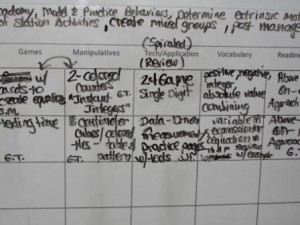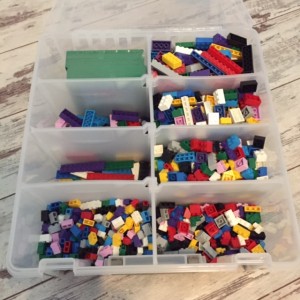
Are you an Algebra teacher who is wanting to begin using math stations, small groups, and guided instruction with your classes?
If you are, then I’m already impressed and the students you have this year will be, too!
Here are a few basic tips for implementing guided math instruction in a secondary classroom:
1. Study your next unit of instruction and give your students a pre-assessment of these concepts. Based on the pre-assessment results and other data, identify the most difficult concepts of the unit. List the reasons why they are most difficult for the students. These are the concepts you will emphasize in teacher-guided small groups and in stations.

2. Look at your scope and sequence. How many blocks or days of instruction do you have to teach the unit? How much time is needed for building the basics of the unit? Plot this into a skeleton long-range planning guide for the unit. This Sample Tabor Rotation, Block Schedule for Algebra I is for the unit on relationships between quantities and expressions.
In the Tabor Rotation Framework this Phase is called Phase 1: Setting the stage. In a secondary class, Phase 1 may be 1-6 blocks long depending on the level of difficulty of the concepts. However, teacher-guided small groups will occur during this time to provide the best venue for students learning and mastering concepts.
3. Plan for math stations. This is Phase 2 of the Tabor Rotation Framework–Varying the Modalities in which students learn. What concepts really need to have manipulatives and concrete experience for students to truly understand the concept? An activity for this concept will go in the Manipulatives Station. An example of this is Poly Pull, MCC9-12.A.APR.1.

What concepts could be practiced and mastered by playing a game? Algebra Bingo, MCC9-12.A.SSE.1a is wonderful game to play when beginning the Algebra unit on expressions.
What concept would be best taught by you to approximately 1/4 of the class at a time? This is the content for the Teacher Time Station when you guide students in learning that most difficult concept. The use of building blocks are great manipulatives to use for Teacher Time, Interpret Expressions, MCC.A.SSE.1.

Are there any concepts that the students need to review? These would go into the Technology/Application Station. An application activity such as Operationally Speaking, MCC9-12.A.SSE.1 is a great way for students to practice the language of operations they will encounter in word problems.
3. Identify any other unit concepts that would be better taught to a small group instead of the whole group. Plan for teacher-guided small groups to occur during a block of instruction. Schedule a teacher-guided session with all levels of students. The ones who have shown mastery of the concept will be met with for a shorter amount of time and their knowledge refined and extended. The approaching-level students will have 5-10 minutes of instruction depending on their needs and their attention spans.
4. Create choice boards for the rest of the class to use while you are teaching guided groups. My blog, What is the Rest of the Class Doing? is a wonderful source for creating these differentiated and engaging tools. There are attachments, links, and lots of resources.
5. Obtain basic games that can be placed in stations and used in choice boards. The 24 Game comes in the Algebra, Integers, and Variable versions to challenge your Algebra students. I also use the 24 Game single and double digit to provide practice in basic facts.
Albert’s Insomnia is another tool for composition of numbers and practice of basic facts.
I would also make sure I had the board game Equate in my classroom. It is played like Scrabble and engages the players in the creation of equations and expressions.
6. As you begin, think about why your are doing this and what your ultimate goal is for your students. Create some type of assessment tool to check for understanding and to provide for individual accountability. Passports are an excellent way to document student understanding. LEGO Logic Passport is a great example of this type of tool.

You can engage Algebra students by simply letting them illustrate problems with LEGO people. They LOVE it!!!
I hope this list provides you with a healthy beginning on your journey. By implementing teacher-guided instruction in your Algebra classroom, you are giving students more of the most valuable asset they can ever have–YOU!

